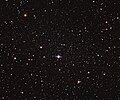Archivo:Carina Dwarf Galaxy.jpg
Apariencia

Tamaño de esta previsualización: 719 × 600 píxeles. Otras resoluciones: 288 × 240 píxeles · 576 × 480 píxeles · 921 × 768 píxeles · 1228 × 1024 píxeles · 2456 × 2048 píxeles · 3771 × 3145 píxeles.
Ver la imagen en su resolución original (3771 × 3145 píxeles; tamaño de archivo: 5,64 MB; tipo MIME: image/jpeg)
Historial del archivo
Haz clic sobre una fecha y hora para ver el archivo tal como apareció en ese momento.
| Fecha y hora | Miniatura | Dimensiones | Usuario | Comentario | |
|---|---|---|---|---|---|
| actual | 13:14 24 feb 2015 |  | 3771 × 3145 (5,64 MB) | FDMS4 | Reverted to version as of 14:03, 28 June 2011. |
| 03:00 24 feb 2015 |  | 3768 × 3144 (5,78 MB) | SteinsplitterBot | Bot: Image rotated by 180° | |
| 14:03 28 jun 2011 |  | 3771 × 3145 (5,64 MB) | Jmencisom |
Usos del archivo
Las siguientes páginas usan este archivo:
Uso global del archivo
Las wikis siguientes utilizan este archivo:
- Uso en af.wikipedia.org
- Uso en ar.wikipedia.org
- Uso en ast.wikipedia.org
- Uso en ca.wikipedia.org
- Uso en de.wikipedia.org
- Uso en el.wikipedia.org
- Uso en en.wikipedia.org
- Uso en fi.wikipedia.org
- Uso en fr.wikipedia.org
- Uso en he.wikipedia.org
- Uso en id.wikipedia.org
- Uso en it.wikipedia.org
- Uso en ja.wikipedia.org
- Uso en ko.wikipedia.org
- Uso en mk.wikipedia.org
- Uso en nl.wikipedia.org
- Uso en no.wikipedia.org
- Uso en pl.wikipedia.org
- Uso en pt.wikipedia.org
- Uso en ro.wikipedia.org
- Uso en ru.wikipedia.org
- Uso en si.wikipedia.org
- Uso en sk.wikipedia.org
- Uso en tr.wikipedia.org
- Uso en uk.wikipedia.org
- Uso en vi.wikipedia.org
- Uso en www.wikidata.org
